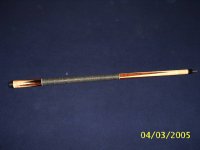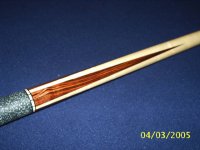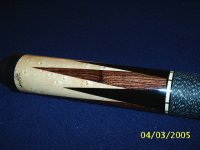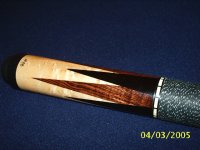When it comes to this cue, the answer is YES! This is a custom cue created by Andy Bruce of Hitt Cues. Now I could have been happy with this cue just for its looks, but the first time I played with this cue I realized the simple truth....IT IS TOO GOOD TO BE TRUE! And I love it. This is one of those rare cues that you don't have to "learn" how to play with. It just feels natural from day one. It has a hit like you wouldn't believe. Anyone who has played with a Hitt Cue knows what I am talking about. And its no wonder. This guy is a perfectionist. For those of you who haven't played with one of his cues, you need to give one a try. You won't regret it.
http://hittcues.researchrobotics.com/
About the cue:
The forearm is made from bird's eye maple with kingwood points and the butt is bird's eye maple with alternating kingwood and ebony points.The kingwood is what got me. First time I saw it, I had to have it. This is truly a beautiful cue, and I know there is no way these pictures do it justice.
http://hittcues.researchrobotics.com/
About the cue:
The forearm is made from bird's eye maple with kingwood points and the butt is bird's eye maple with alternating kingwood and ebony points.The kingwood is what got me. First time I saw it, I had to have it. This is truly a beautiful cue, and I know there is no way these pictures do it justice.




